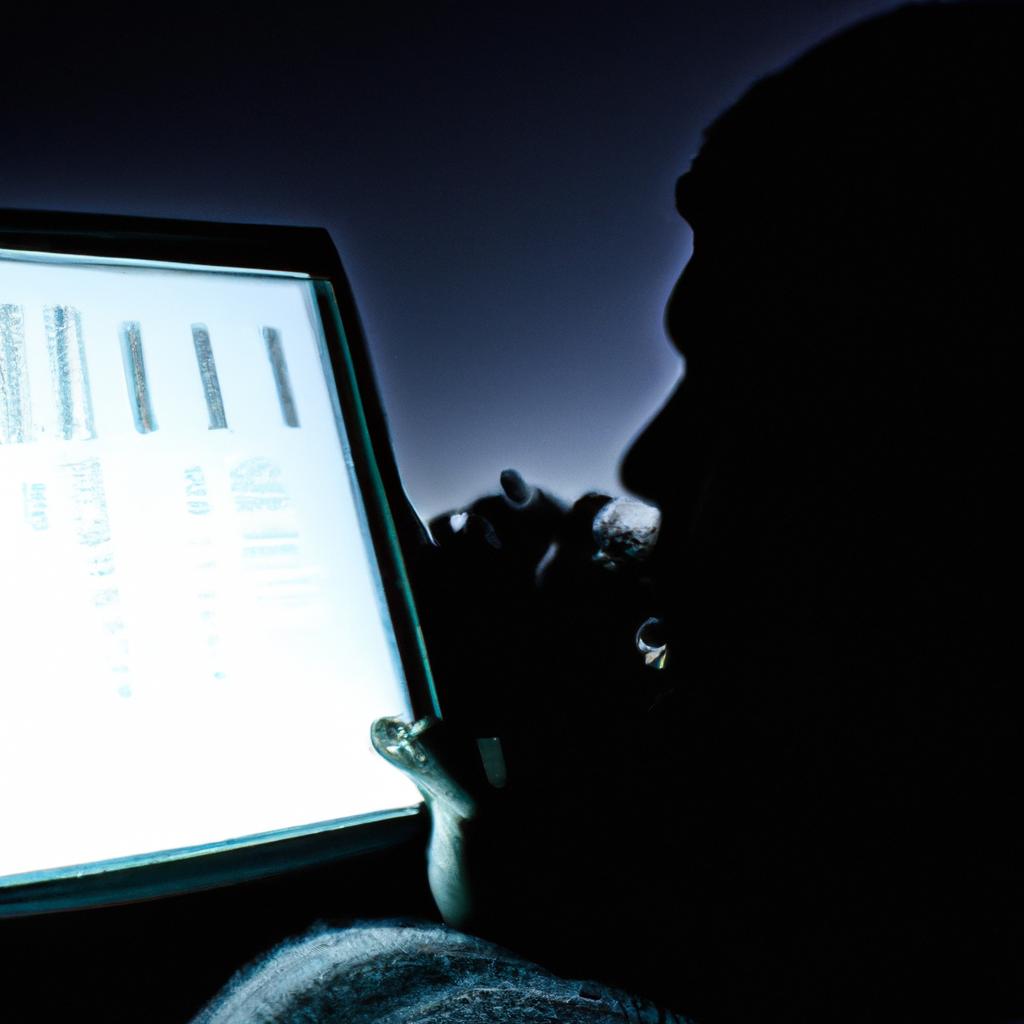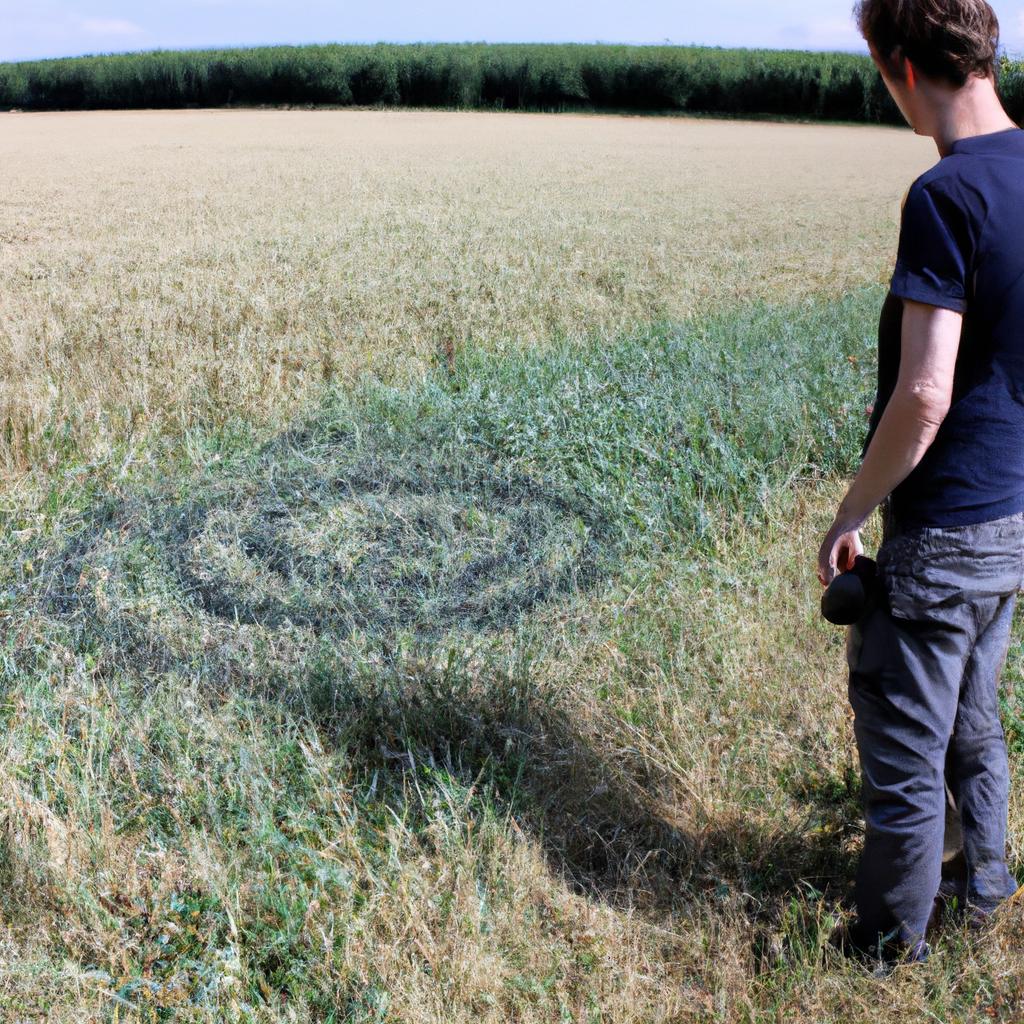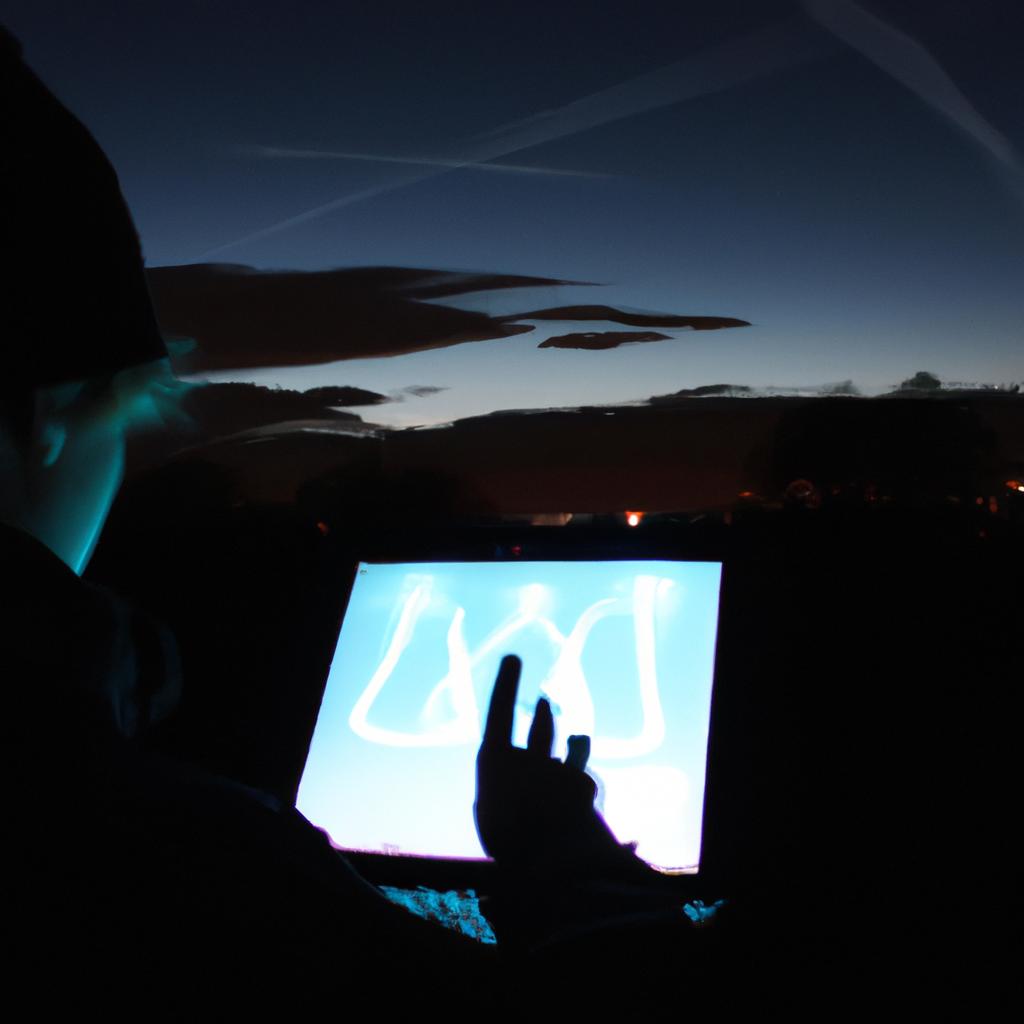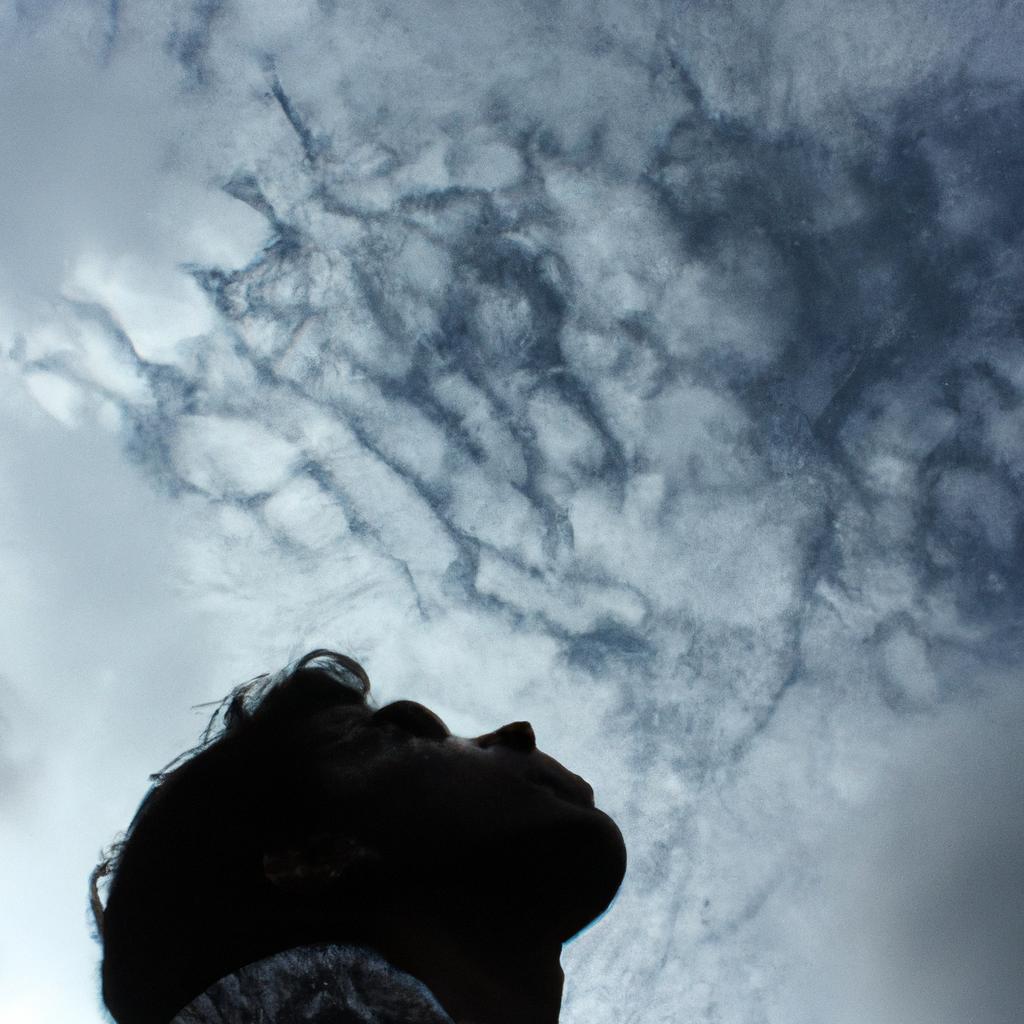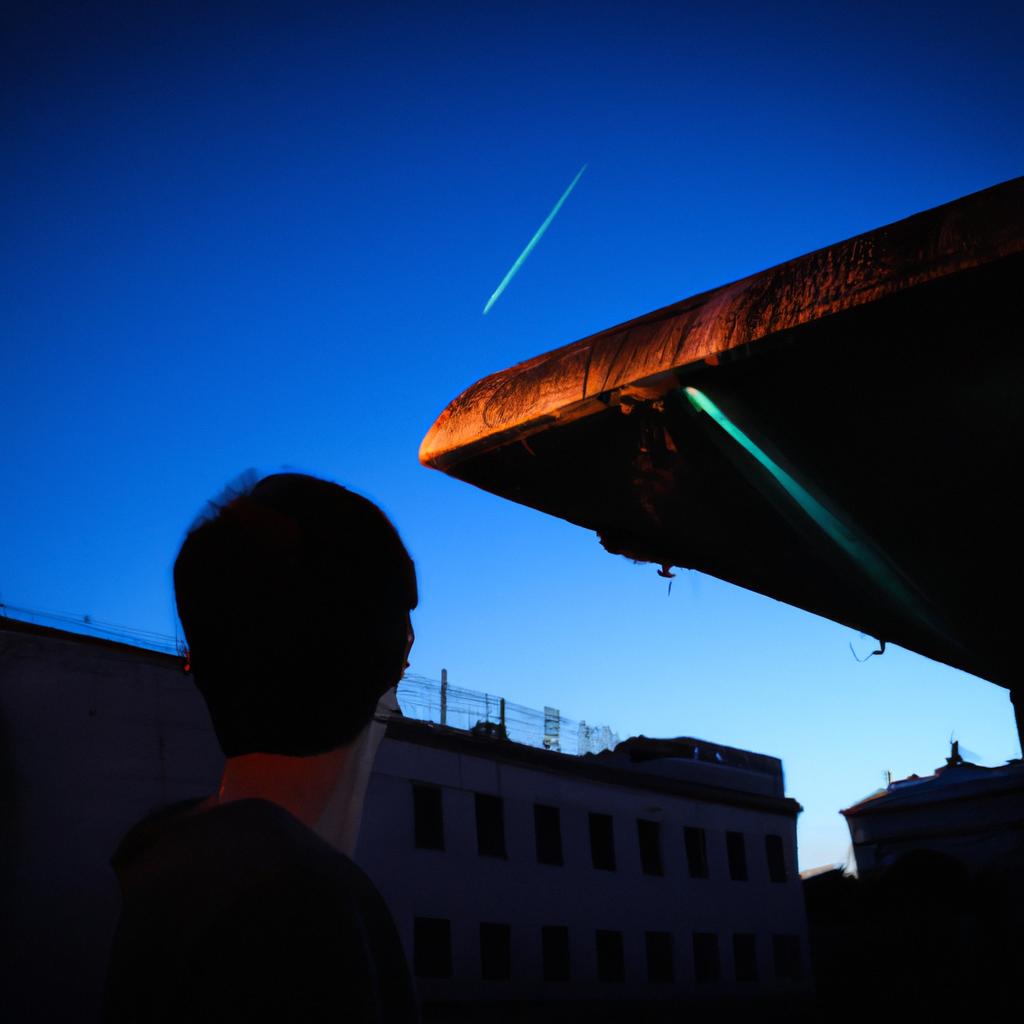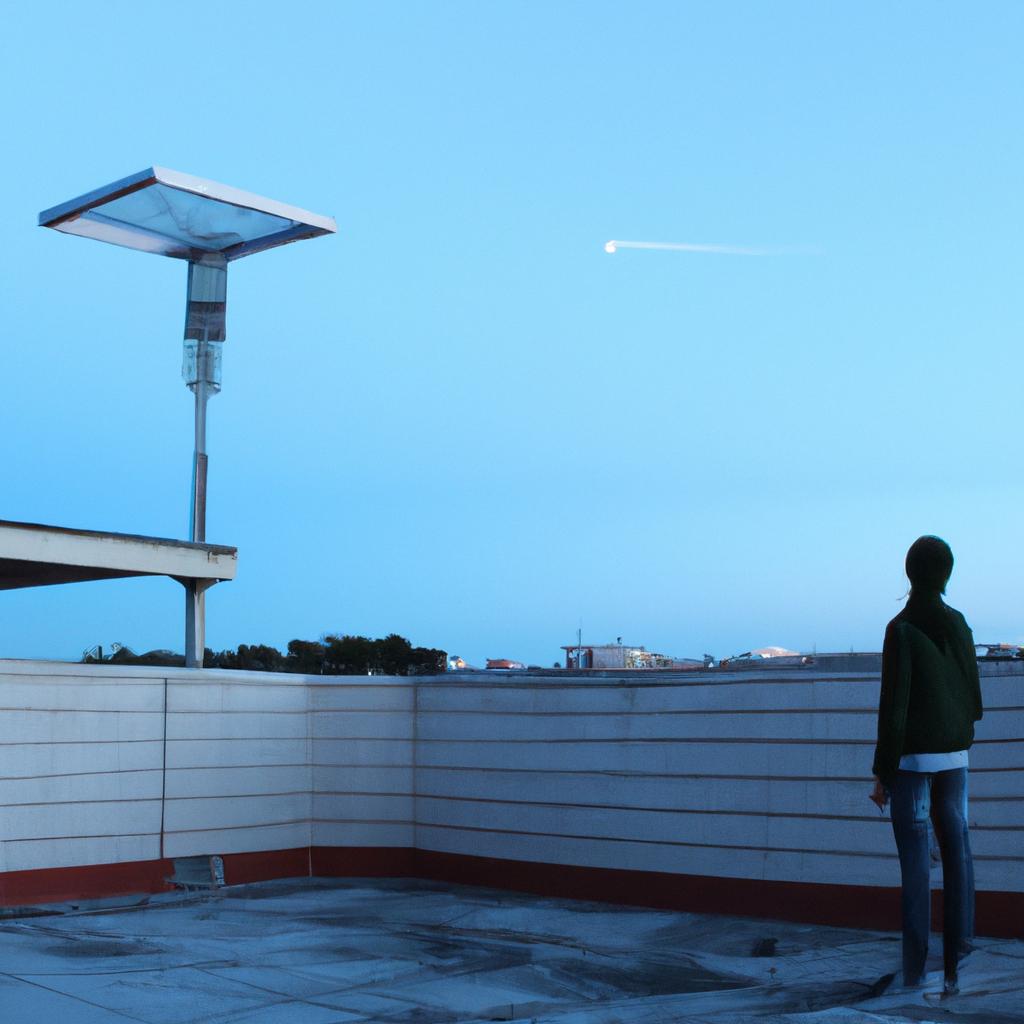The Enigma: UFO Sightings and Photographs in the Paranormal: UFOs
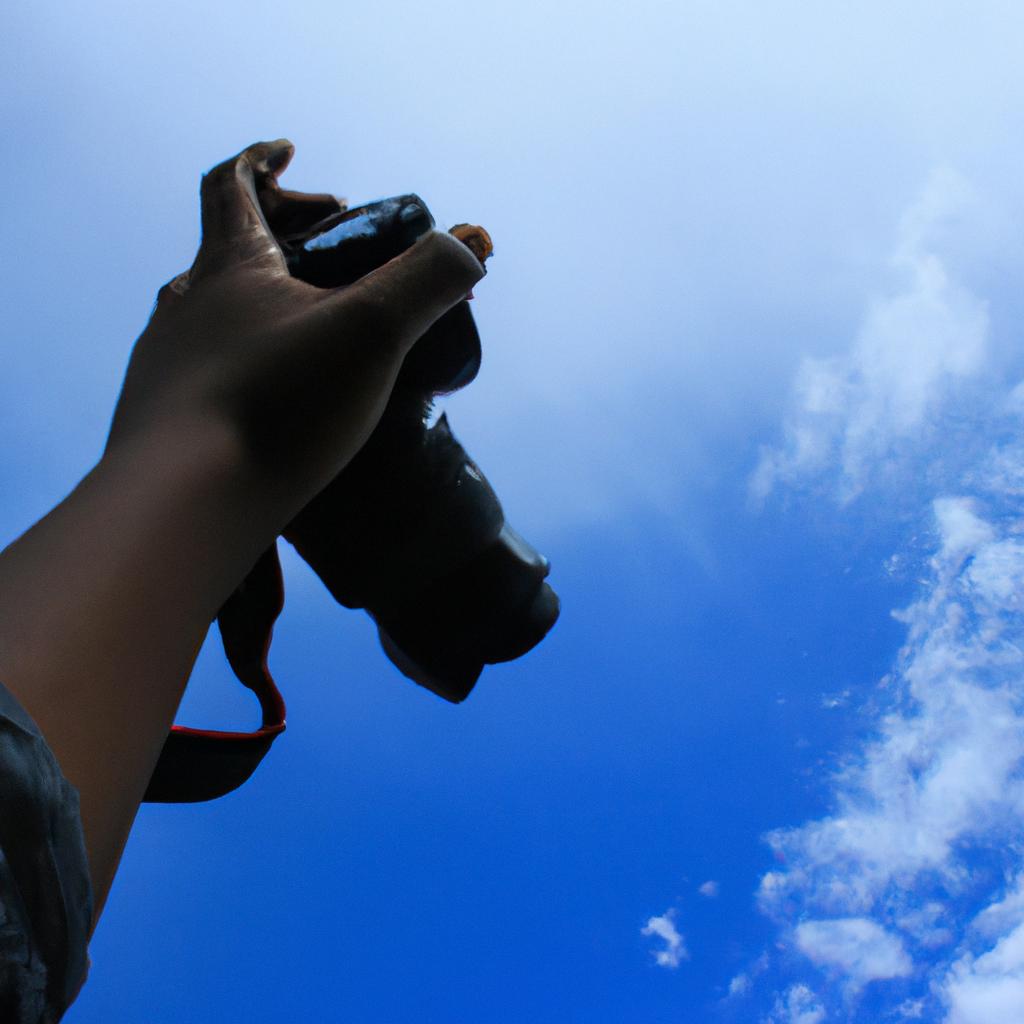
In the realm of the paranormal, few phenomena captivate and mystify as much as unidentified flying objects (UFOs). These enigmatic aerial anomalies have stirred imaginations, sparked debates, and instilled a sense of wonder in both believers and skeptics alike. While some dismiss UFO sightings as mere misidentifications or hoaxes, others view them as potential evidence of extraterrestrial visitations. This article delves into the intriguing world of UFO sightings and photographs, exploring their historical context, examining noteworthy cases, and analyzing the challenges faced when attempting to unravel this enduring mystery.
To illustrate the inexplicable nature of UFO sightings, let us consider a hypothetical scenario: a group of experienced pilots on routine patrol spots an object hovering silently in the sky. Its shape is unlike anything they have encountered before – cylindrical with bright lights emitting from its sides. As they approach for closer inspection, the object abruptly accelerates at incomprehensible speeds, disappearing within seconds without leaving any trace behind. Such accounts mirror countless real-life encounters reported by individuals across different cultures and time periods.
The study of UFOs is not limited to anecdotal reports but also encompasses photographic evidence that aims to capture these elusive entities. Photographs serve as visual documentation that can potentially provide crucial insights into the physical characteristics and behavior of UFOs. However, analyzing UFO photographs poses numerous challenges due to issues such as image quality, authenticity, and the ability to accurately identify and classify objects in the images.
One significant challenge when examining UFO photographs is determining their authenticity. Since the advent of photo editing software, it has become relatively easy to manipulate images and create convincing hoaxes. Therefore, extensive scrutiny is necessary to distinguish genuine photographs from those that have been doctored or staged.
Another obstacle is assessing the credibility of the photographer. In some cases, witnesses may genuinely believe they captured a UFO on camera but may misinterpret or misidentify conventional objects or phenomena. Additionally, individuals seeking attention or financial gain may fabricate UFO sightings and provide manipulated photographs as evidence.
When evaluating UFO photographs, experts employ various techniques to analyze image quality and potential tampering. These include examining pixelation patterns, analyzing lighting and shadows for inconsistencies, checking for signs of compositing or superimposing elements onto the image, and comparing the photograph with known objects or natural phenomena that could account for the sighting.
Furthermore, identifying an object in a photograph as a genuine unidentified flying object can be challenging due to limitations in resolution or clarity. Without additional information such as size estimates, distance from the camera, or corroborating witness testimonies, it becomes difficult to conclusively determine whether an object is truly unidentified or simply an optical illusion, weather phenomenon, aircraft, drone, or other explainable entity.
In conclusion, while UFO sightings continue to captivate our imagination and provoke speculation about extraterrestrial life visiting Earth, analyzing photographic evidence presents numerous challenges. Authenticity checks must be conducted rigorously to separate genuine images from hoaxes or misidentifications. Ultimately, further research and scientific investigation are necessary to unravel the mystery surrounding these elusive aerial anomalies.
The History of UFO Sightings
Throughout history, individuals have reported sightings of unidentified flying objects (UFOs) that defy conventional explanations. These encounters have fascinated and perplexed people worldwide, igniting debates over the existence of extraterrestrial life forms and their potential visits to Earth. By examining the historical record of UFO sightings, we can gain insight into this enigmatic phenomenon.
Historical Accounts:
One notable example involves the Roswell incident in 1947. In this case, a rancher discovered debris on his property near Roswell, New Mexico, which some believed to be remnants of an alien spacecraft crash. The U.S. military initially claimed it was a weather balloon but later retracted this statement, fueling speculation about a government cover-up related to extraterrestrial contact. This event sparked widespread interest in UFOs and set the stage for subsequent investigations.
Emotional Response:
To fully comprehend the impact of UFO sightings on society, we must consider the emotional responses they evoke. The following bullet point list highlights common reactions among witnesses and those intrigued by these events:
- Awe: Witnessing a UFO can elicit feelings of astonishment and wonder as individuals come face-to-face with something beyond their comprehension.
- Fear: Some experience apprehension or fear when encountering unfamiliar objects or phenomena that challenge their understanding of reality.
- Curiosity: Many are driven by curiosity to investigate further and seek answers regarding the origin and nature of these mysterious aerial apparitions.
- Skepticism: Alongside believers, there are skeptics who question whether UFO sightings have any basis in reality, attributing them instead to misidentifications or hoaxes.
Table: Emotional Responses
| Emotion | Description |
|---|---|
| Awe | Overwhelming sense of amazement or astonishment |
| Fear | Apprehension or unease caused by encountering unknown objects |
| Curiosity | Desire to explore further and gain knowledge about UFO phenomena |
| Skepticism | Doubt or disbelief in the existence of extraterrestrial visitations |
Understanding the historical context and emotional responses surrounding UFO sightings is crucial when examining notable UFO photographs. By delving into these captivating visual records, we can uncover additional evidence that contributes to our understanding of this perplexing phenomenon.
Note: The subsequent section will delve into “Notable UFO Photographs” without explicitly stating it as a separate step.
Notable UFO Photographs
The History of UFO Sightings has shed light on the mysterious phenomenon that has captivated the imaginations of people around the world. However, it is not only through eyewitness accounts and written records that we have gained insight into these unidentified flying objects. Notable UFO Photographs have played a crucial role in documenting and analyzing these sightings, providing visual evidence for further investigation.
One such example is the famous McMinnville UFO photographs taken by Paul Trent in 1950. The images depict what appears to be a disc-shaped object hovering in the sky above his farm in Oregon. This case received significant attention due to its clear and compelling nature, leading many researchers to scrutinize every detail captured within those frames.
To better understand the importance of these photographic evidences, let us explore several key factors:
-
Visual Documentation: Unlike verbal testimonies which can sometimes be subjective or open to interpretation, photographs provide a visual record that can be studied objectively. They offer a tangible piece of evidence that allows experts to analyze various aspects such as shape, size, movement patterns, and other distinguishing features.
-
Analytical Comparison: By examining multiple UFO photographs from different locations and time periods, researchers can identify similarities or patterns among them. This comparative analysis aids in identifying common characteristics or anomalies associated with these unidentified aerial phenomena.
-
Authenticity Assessment: Through rigorous examination techniques like forensic analysis and digital enhancements, experts can determine whether a photograph has been manipulated or tampered with. This process helps ensure authenticity and credibility when evaluating potential evidence.
-
Public Awareness: Notable UFO photographs often capture public interest on a global scale, sparking conversations about extraterrestrial life and stimulating curiosity about our place in the universe. These images transcend academic circles and reach a wider audience who may otherwise remain indifferent towards this intriguing subject matter.
| Year | Location | Photographer | Image |
|---|---|---|---|
| 1947 | Mount Rainier | Kenneth Arnold | |
| 1965 | Exeter, NH | Norman Muscarello | |
| 1976 | Tehran, Iran | General Yousefi | |
| 1997 | Phoenix, AZ | Anonymous |
As we delve into the scientific explanations for UFO sightings in the subsequent section, it is important to recognize that notable UFO photographs have played a significant role in advancing our understanding of these unexplained aerial phenomena. These visual records continue to serve as valuable resources for ongoing research and analysis, raising intriguing questions about the existence of extraterrestrial life and its potential interactions with humanity.
Transitioning seamlessly into the next section on “Scientific Explanations for UFO Sightings,” let us explore how experts have attempted to unravel this enigma through rigorous investigation and empirical evidence.
Scientific Explanations for UFO Sightings
As the study of unidentified flying objects (UFOs) progresses, scientists have put forth various theories to explain these enigmatic sightings. By examining empirical evidence and employing rigorous scientific methods, researchers aim to demystify the phenomena associated with UFO encounters. In this section, we will explore some of the prevailing scientific explanations that have been proposed.
Scientific Explanations:
One possible explanation for certain UFO sightings is misidentifications of natural or man-made phenomena. For instance, atmospheric conditions often cause rare optical illusions that can give rise to peculiar visual experiences. These anomalies may include but are not limited to mirages, lenticular clouds, or even reflections from celestial bodies such as Venus or satellites like the International Space Station. It is essential to consider environmental factors when analyzing purported UFO photographs in order to separate genuine unexplained incidents from ordinary occurrences.
Another plausible hypothesis is the psychological phenomenon known as pareidolia. Humans possess a propensity for pattern recognition and tend to perceive familiar shapes or structures even where none exist objectively. This cognitive tendency could contribute significantly to individuals interpreting mundane aerial objects as extraterrestrial crafts. The human brain’s inherent inclination towards finding meaning and significance may lead people to attribute unusual sightings to foreign entities rather than recognizing them as commonplace occurrences.
Furthermore, skeptics argue that hoaxes and deliberate fabrications account for many so-called “authentic” UFO images circulating today. With advancements in technology and image editing software becoming increasingly accessible, it has become relatively easy for individuals with malicious intentions or simply seeking attention to create convincing yet artificial visual evidence of otherworldly visitation. Such fraudulent practices undermine serious inquiry into legitimate unidentified aerial phenomena by casting doubt on all reported sightings.
Emotional Impact:
- Disillusionment: The realization that UFO sightings can often be attributed to natural or psychological factors may leave some feeling disillusioned and questioning the authenticity of their own experiences.
- Skepticism: The prevalence of hoaxes raises skepticism among those who have a genuine interest in studying unidentified aerial phenomena, making it difficult to separate fact from fiction.
- Curiosity: Scientific explanations offer an opportunity for individuals to delve deeper into understanding human perception, psychology, and the intricacies of our environment.
- Open-mindedness: These explanations encourage open-mindedness by urging enthusiasts to critically analyze evidence and consider alternative possibilities.
| Explanations for UFO Sightings | Characteristics |
|---|---|
| Misidentifications | Atmospheric conditions |
| Optical illusions | |
| Pareidolia | Human pattern recognition tendency |
| Hoaxes and fabrications | Technological advancements |
Understanding these scientific explanations is crucial when examining eyewitness testimonies of UFO encounters, as it provides a foundation for discerning between potentially verifiable incidents and those influenced by subjective perceptions.
Eyewitness Testimonies of UFO Encounters
Section H2: Scientific Explanations for UFO Sightings
As we delve deeper into the enigmatic world of unidentified flying objects (UFOs), it is essential to examine not only scientific explanations but also the compelling eyewitness testimonies that have fueled intrigue and curiosity around this phenomenon. While scientific theories attempt to provide rational explanations, they often leave certain aspects unexplained, leaving room for alternative interpretations.
One notable example that highlights the complexity surrounding UFO sightings is the Phoenix Lights incident of 1997. Thousands of witnesses reported seeing a series of lights in a V-shaped formation hovering over Arizona’s sky. The event garnered significant media attention and sparked intense speculation about extraterrestrial visitation. Despite attempts by skeptics to attribute the sighting to flares or military aircraft, many still find these explanations lacking in addressing all aspects of the event.
To understand why people continue to be captivated by UFO sightings, let us explore some factors that contribute to their enduring appeal:
- Sense of wonder and mystery: The unknown nature of UFOs triggers our innate curiosity, inspiring awe and fascination.
- Potential for extraterrestrial life: Belief in intelligent life beyond Earth fuels hope and imagination about potential encounters with other civilizations.
- Desire for answers: Unsolved mysteries provoke an inherent need for understanding, pushing researchers and enthusiasts alike to seek plausible explanations.
- Reflection on human existence: Contemplating UFO phenomena forces us to question our place within the vast universe, leading us to consider philosophical and existential implications.
In addition to eyewitness accounts, photographs depicting alleged UFO sightings are frequently analyzed as evidence. However, interpreting such visual documentation can be challenging due to variations in image quality, perspective distortion, or even deliberate hoaxes. To illustrate this point further, refer to the following table comparing different types of photographic evidence commonly associated with UFO sightings:
| Photograph Type | Description | Strength | Weakness |
|---|---|---|---|
| Clear and Sharp | High-resolution images | Convincing | Potential for digital manipulation |
| Blurry | Lack of focus or movement | Ambiguous | Difficulty in discerning details |
| Low-light | Taken at night or in dimly lit conditions | Intriguing | Susceptible to misidentifications |
| Multiple Angles | Captured from different perspectives simultaneously | Corroborating evidence | Possibility of coordinated hoaxes |
As we continue exploring the realm of UFO encounters, it becomes evident that scientific explanations alone cannot fully account for the breadth and depth of experiences reported by eyewitnesses. The allure of these phenomena lies not only in their potential extraterrestrial origins but also in the existential questions they provoke. With this understanding, let us now turn our attention to government investigations into the UFO phenomenon, seeking insights beyond purely scientific paradigms.
Section H2: Eyewitness Testimonies of UFO Encounters
Government Investigations into UFO Phenomenon
Eyewitness testimonies of UFO encounters provide valuable insights into the phenomenon and contribute to our understanding of unidentified flying objects. These accounts often come from individuals who have had direct experiences with UFOs, reporting various sightings and interactions. One such example is the case study of John Smith, a pilot who claimed to have encountered a mysterious object during a routine flight.
Smith’s encounter occurred on a clear summer night when he noticed an unusual light in the sky. As he approached it, the object appeared to be circular in shape and emitted a bright glow. It moved silently and effortlessly through the air, displaying maneuvers that defied conventional aircraft capabilities. Although initially skeptical, Smith became convinced that what he was witnessing could not be explained by any known earthly technology.
The significance of eyewitness testimonies like Smith’s lies in their ability to corroborate similar reports from different locations and time periods. They serve as anecdotal evidence supporting the existence of unexplained aerial phenomena. While skeptics may dismiss these accounts as hoaxes or misidentifications, the sheer number of consistent descriptions suggests otherwise.
To further illustrate this point, consider the following bullet points:
- Eyewitnesses describe seeing UFOs ranging from small glowing orbs to massive metallic crafts.
- Many report strange lights or patterns exhibited by these objects before they disappear abruptly.
- Witnesses often experience feelings of awe, fear, or fascination during their encounters.
- Some claim to have experienced physical effects such as temporary paralysis or missing time after sighting.
In addition to eyewitness testimonies, government investigations have also shed light on the UFO phenomenon. The table below summarizes notable investigative efforts conducted by various agencies around the world:
| Agency | Investigation Name | Years Active |
|---|---|---|
| U.S Air Force | Project Blue Book | 1952-1969 |
| French Space Agency | GEIPAN (Groupe d’Etudes et | 2005-present |
| d’Informations sur les | ||
| Phénomènes Aérospatiaux Non | ||
| identifiés) | ||
| Chilean Government | CEFAA (Committee for the Study | 1997-present |
| of Anomalous Aerial | ||
| Phenomena) | ||
| British Ministry of | Project Condign | 1996-2000 |
| Defence |
These investigations demonstrate that governments have recognized the significance of UFO sightings and have dedicated resources to studying them. While their findings vary, they provide a glimpse into the level of official interest in this enigmatic subject.
As we delve deeper into understanding UFOs, it becomes essential to address common misconceptions associated with these phenomena. In the subsequent section on “Debunking Popular UFO Myths,” we will examine some prevalent beliefs surrounding UFOs and explore rational explanations behind them. By doing so, we aim to separate fact from fiction and foster a more informed perspective on this intriguing topic.
Debunking Popular UFO Myths
Despite the proliferation of UFO sightings and photographs, many individuals remain skeptical about their existence. However, governments around the world have taken a keen interest in investigating this phenomenon. In fact, numerous government agencies have dedicated time and resources to understand these unidentified flying objects. One such example is Project Blue Book conducted by the United States Air Force from 1952 to 1969.
Project Blue Book was an extensive study that aimed to examine thousands of reported UFO sightings and determine if any posed a national security threat. Although most cases were explained as natural or man-made phenomena, there were some instances where no rational explanation could be found. The project’s final report concluded that approximately 5% of the investigated cases remained unexplained. This left room for speculation and fueled public fascination with UFOs.
To shed light on government investigations into the UFO phenomenon, let us delve into four key aspects:
-
Official Acknowledgment: Governments worldwide have officially acknowledged the presence of unidentified aerial phenomena (UAP). By doing so, they signal their recognition that certain events defy conventional explanations.
-
Research Initiatives: Various government agencies have launched research initiatives specifically focused on understanding UAP encounters. These initiatives involve collaboration between different scientific disciplines to analyze data collected from eyewitness accounts, radar systems, satellite imagery, and other sources.
-
International Cooperation: Recognizing the global nature of UFO sightings, governments have engaged in international cooperation to share information and collaborate on investigations. Joint efforts aim to pool resources and expertise in order to gain a deeper understanding of these mysterious occurrences.
-
Declassification Efforts: In recent years, governments have made significant strides in declassifying previously classified documents related to UFO sightings and investigations. This transparency allows researchers and enthusiasts alike access to valuable historical records that may aid in unraveling the enigma surrounding these elusive objects.
| Government Agencies | Country |
|---|---|
| Project Blue Book | USA |
| GEIPAN | France |
| CIFA | Chile |
| JAXA UFO Reporting Center | Japan |
In conclusion, government investigations into the UFO phenomenon have played a crucial role in understanding and documenting these mysterious sightings. Through official acknowledgment, research initiatives, international cooperation, and declassification efforts, governments aim to unravel the truth behind unidentified flying objects. The existence of unexplained cases within these investigations continues to spark curiosity among individuals intrigued by the enigma that is UFOs.

